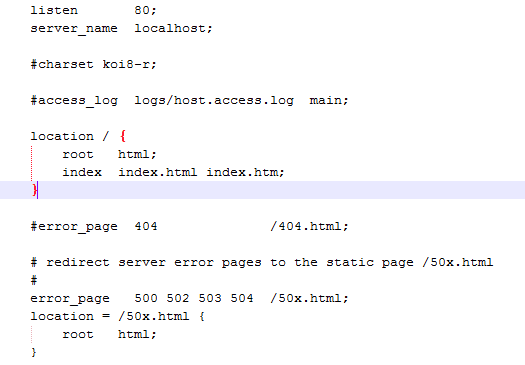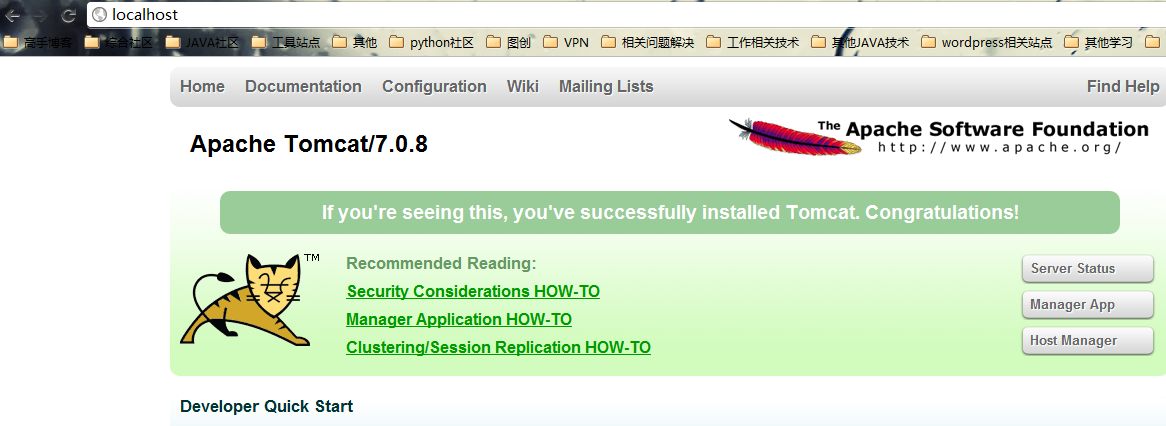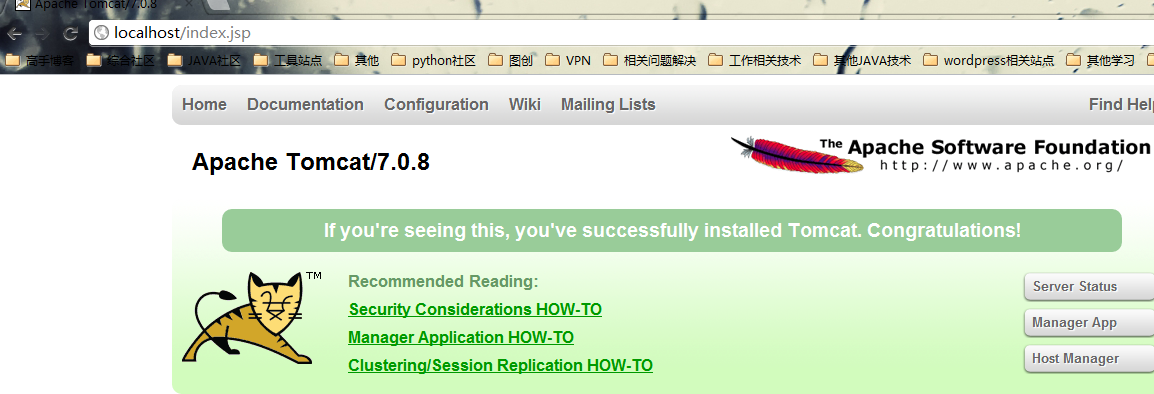How to use Nginx as reverse proxy for Tomcat server
1) Of course you need to download the software you want to use. Go to the nginx official website for the next one. http://nginx.org/en/download.html can be found here. The version I am using now is 1.1.7, but basically all future versions are compatible, and what we are using does not involve too low-level aspects, so there should be no changes. Here, since mine is Windows, of course I download the Windows version. After downloading, you need to start it first. Enter the nginx folder and start nginx directly. For example, after downloading, I put it in d:\software\developertools\server\nginx-1.1.7, directly cmd and then cd d:\software\developertools\server\nginx-1.1.7. Some people who are not used to the command line may be surprised. It doesn't proceed to that folder. Windows will not jump between partitions unless you specify it yourself. So we have to directly d: as follows:

Then, we start nginx directly. Here you may see a window flashing by. According to our use of tomcat If the experience passes by in a flash, it proves that something is wrong, right? But it's not.

#At this time we open the task manager and can see two nginx.exe there. This shows that we have already started. As for why, we will not delve into it here.

Now that we have started nginx, we can start tomcat. If we want to directly access http://localhost, we can directly access tomcat. Don't worry, let's take a look at what nginx looks like after starting. Directly accessing http://localhost can see:

We can see that nginx started successfully, and now the access is directly into the nginx directory. So where are these actually configured. This involves nginx.conf, an important configuration file of nginx.
2) We can see that there is a conf folder in the nginx folder, which contains several files. Regardless of the others, we open nginx.conf and we can see a paragraph:

This code is in the server and is equivalent to a proxy server. Of course, multiple ones can be configured. Let's analyze it carefully: listen: Indicates the port that the current proxy server listens to. The default is to listen to port 80. Note that if we configure multiple servers, the listener must be configured differently, otherwise we will not be able to determine where to go. server_name: Indicates where to go after listening. At this time, we go directly to the local area. At this time, it is directly to the nginx folder. location: Indicates the matching path. If / is configured, it means that all requests will be matched here. Root: If root is configured, it means that when the path of this request is matched, the corresponding file will be found in this folder. Here It will be useful for our later static file serving. index: When no home page is specified, the specified file will be selected by default. There can be multiple files and they will be loaded in order. If the first one does not exist, the second one will be found, and so on. The error_page below is the page that represents the error. We will not use it here for the time being, so we will ignore it for now.
Now that we know the specific configuration, how to make it switch to tomcat when accessing localhost. In fact, only two places have been modified:
1 2 |
|
We have modified the above two places. My tomcat is on port 8080, which can be modified according to your own needs. There is a new element proxy_pass here, which represents the proxy path, which is equivalent to forwarding, unlike the root that must be specified before. Now that we have modified the file, does it mean that we must shut down nginx and then restart it? In fact, it is not necessary, nginx can reload the file. We run directly: nginx -s reload
We were too happy, we found an error:

What did it come from, the error was found on line 45, We didn’t want to find } in that line, so we looked carefully and found that the proxy_pass we added was very strange. It didn’t end with a ; sign. This was the problem. We modified it directly and then ran it again. We found that there was no error and it was ok. If you don't want to load it directly, but just want to see if there are any problems with your configuration file, you can directly enter: nginx -t
This can check whether there are errors in the configuration file. All our modifications below assume that we run nginx -s reload to reload the configuration file after the modification is completed. Please note.
Everything is fine, then we reopen http://localhost and we see the following page:

这时,我们发现它并不是刚才的welcome页面了,而是tomcat的管理页面了,不管我们点击什么链接都是没问题的,相当于直接访问http://localhost:8080一样。
3)上面我们直接试了一个小例子,让nginx进行转发,即所谓的反向代理。但实际上我们的需求不会是这样的,我们需要分文件类型来进行过滤,比如jsp直接给tomcat处理,因为nginx并不是servlet容器,没办法处理jsp,而html,js,css这些不需要处理的,直接给nginx进行缓存。下面我们来进行一下配置,让jsp页面直接给tomcat,而html,png等一些图片和js等直接给nginx进行缓存。这时最主要用的还是location这个元素,并且涉及到一部分正则,但不难:
1 2 3 4 |
|
我们先要去掉之前配的location /,避免全部请求被拦截了。然后我们再来看看http://localhost

当我们不指定jsp页面的时候,它会出现找不到,因为,此时并没有相应的location匹配,所以就会有404错误,这时就跳到了nginx自定义的error页面去了。而当我们用http://localhost/index.jsp去访问时,我们看到了熟悉的页面:

而且图片那些都显示正常,因为图片是png的,所以直接在tomcat/webapps/root目录下直接查找,当然,如果我们点击manager application how-to这个链接,我们发现:

它还是找不到,为什么呢?因为这是个html页面,但它并不在root目录下,而是在docs目录下,但当我们匹配html时,我们却到root目录下去找,所以还是找不到这个页面。
一般情况下,如果我们需要用nginx来进行静态文件伺服,一般都会把所有静态文件,html,htm,js,css等都放在同一个文件夹下,这样就不会有tomcat这样的情况了,因为tomcat下的是属于不同的项目,这个我们就没办法了。
3)有些人会说,这些都只会找一台服务器,但如果我们想在一台服务器挂了的时候,自动去找另外一台,这怎么办?这实际上nginx都考虑到了。这时,我们之前用的proxy_pass就有大用途了。我们把之前的第一个例子,即全部都代理的修改一下:最后修改如下:
1 2 3 4 5 6 7 8 |
|
我们在server外添加了一个upstream,而直接在proxy_pass里面直接用http://+upstream的名称来使用。我们还是直接来http://localhost,还是和第一个一样的效果,所有链接都没问题,说明我们配置正确。upstream中的server元素必须要注意,不能加http://,但proxy_pass中必须加。我们刚才说可以在一个服务器挂了的情况下连到另外一个,那怎么弄呢?其实很简单,在upstream中的local_tomcat中配置多一个server。比如我现在弄多一个jetty,端口在9999,所以我们配置如下:
1 2 |
|
此时,我们关闭tomcat,而只开jetty。我们来运行http://localhost看看效果: 我们看到它请求到了jetty的页面,但由于jetty的机制,这时没有显示jetty主页,这个我们先不管。但我们的在一个服务器挂的情况下自动使用另外一个的功能实现了。
但有时我们就不想它挂的时候访问另外一个,而只是希望一个服务器访问的机会比另外一个大,这个可以在server最后加上一个weight=数字来指定,数字越大,表明请求到的机会越大。
1 2 |
|
这时我们给了jetty一个更高的权值,让它更有机会访问到,实际上当我们刷新http://localhost访问的时候发现jetty访问机率大很多,tomcat几乎没机会访问,一般情况下,如果我们必须这样用,不要相关太大,以免一个服务器负载太大。当然,server还有一些其他的元素,比如down表示暂时不用到该服务器等等。
The above is the detailed content of How to use Nginx as reverse proxy for Tomcat server. For more information, please follow other related articles on the PHP Chinese website!

Hot AI Tools

Undresser.AI Undress
AI-powered app for creating realistic nude photos

AI Clothes Remover
Online AI tool for removing clothes from photos.

Undress AI Tool
Undress images for free

Clothoff.io
AI clothes remover

AI Hentai Generator
Generate AI Hentai for free.

Hot Article

Hot Tools

Notepad++7.3.1
Easy-to-use and free code editor

SublimeText3 Chinese version
Chinese version, very easy to use

Zend Studio 13.0.1
Powerful PHP integrated development environment

Dreamweaver CS6
Visual web development tools

SublimeText3 Mac version
God-level code editing software (SublimeText3)

Hot Topics
 1377
1377
 52
52
 How to generate URL from html file
Apr 21, 2024 pm 12:57 PM
How to generate URL from html file
Apr 21, 2024 pm 12:57 PM
Converting an HTML file to a URL requires a web server, which involves the following steps: Obtain a web server. Set up a web server. Upload HTML file. Create a domain name. Route the request.
 Reasons for garbled characters in tomcat
Apr 21, 2024 am 10:18 AM
Reasons for garbled characters in tomcat
Apr 21, 2024 am 10:18 AM
Reasons for Tomcat garbled characters: 1. Character set mismatch; 2. HTTP response header is not set correctly; 3. Filter or encoder configuration error; 4. Web page encoding is incorrect; 5. Other reasons (including server-side language, database encoding and proxy server issues).
 How to add a server in eclipse
May 05, 2024 pm 07:27 PM
How to add a server in eclipse
May 05, 2024 pm 07:27 PM
To add a server to Eclipse, follow these steps: Create a server runtime environment Configure the server Create a server instance Select the server runtime environment Configure the server instance Start the server deployment project
 How to access the page after tomcat is started
Apr 21, 2024 am 10:30 AM
How to access the page after tomcat is started
Apr 21, 2024 am 10:30 AM
To access the page after Tomcat is started, you need to: start the Tomcat server; determine the port number (default 8080); splice the URL, including IP address, port number and page path; use a web browser to access the spliced URL; identify the Tomcat welcome page; Use the same format to access other pages.
 How to deploy and maintain a website using PHP
May 03, 2024 am 08:54 AM
How to deploy and maintain a website using PHP
May 03, 2024 am 08:54 AM
To successfully deploy and maintain a PHP website, you need to perform the following steps: Select a web server (such as Apache or Nginx) Install PHP Create a database and connect PHP Upload code to the server Set up domain name and DNS Monitoring website maintenance steps include updating PHP and web servers, and backing up the website , monitor error logs and update content.
 How to use Fail2Ban to protect your server from brute force attacks
Apr 27, 2024 am 08:34 AM
How to use Fail2Ban to protect your server from brute force attacks
Apr 27, 2024 am 08:34 AM
An important task for Linux administrators is to protect the server from illegal attacks or access. By default, Linux systems come with well-configured firewalls, such as iptables, Uncomplicated Firewall (UFW), ConfigServerSecurityFirewall (CSF), etc., which can prevent a variety of attacks. Any machine connected to the Internet is a potential target for malicious attacks. There is a tool called Fail2Ban that can be used to mitigate illegal access on the server. What is Fail2Ban? Fail2Ban[1] is an intrusion prevention software that protects servers from brute force attacks. It is written in Python programming language
 How to deploy war package in tomcat
Apr 21, 2024 am 10:23 AM
How to deploy war package in tomcat
Apr 21, 2024 am 10:23 AM
The steps to deploy the WAR package to Tomcat are as follows: Copy the WAR package to the webapps directory of Tomcat. Start the Tomcat server and it will automatically deploy the WAR package. Access the application by entering the application's context path into the browser.
 Come with me to learn Linux and install Nginx
Apr 28, 2024 pm 03:10 PM
Come with me to learn Linux and install Nginx
Apr 28, 2024 pm 03:10 PM
Today, I will lead you to install Nginx in a Linux environment. The Linux system used here is CentOS7.2. Prepare the installation tools 1. Download Nginx from the Nginx official website. The version used here is: 1.13.6.2. Upload the downloaded Nginx to Linux. Here, the /opt/nginx directory is used as an example. Run "tar-zxvfnginx-1.13.6.tar.gz" to decompress. 3. Switch to the /opt/nginx/nginx-1.13.6 directory and run ./configure for initial configuration. If the following prompt appears, it means that PCRE is not installed on the machine, and Nginx needs to




